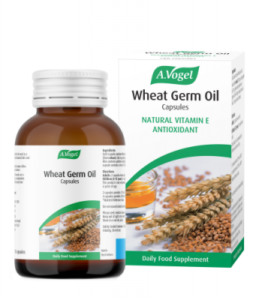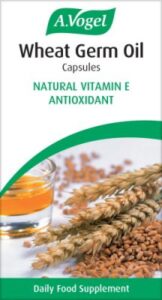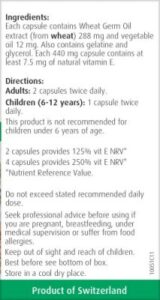






Wheat Germ Oil 120 Capsuls A Vogel
£12.99 Original price was: £12.99.£10.39Current price is: £10.39.
Wheat Germ
A Vogel Wheat germ, the embryo of the wheat kernel, is packed with nutrients and offers several potential health benefits. Here are some of the key benefits associated with consuming wheat germ:
1. **Nutrient-Rich:**
– Wheat germ is a concentrated source of nutrients, including vitamins, minerals, protein, healthy fats, and antioxidants. It contains significant amounts of vitamin E, folate, thiamine, phosphorus, magnesium, zinc, and iron, among other essential nutrients.
2. **Rich in Vitamin E:**
– Wheat germ is one of the best food sources of vitamin E, a potent antioxidant that helps protect cells from damage caused by free radicals. Vitamin E supports immune function, skin health, heart health, and may have anti-aging effects.
3. **Heart Health:**
– The high levels of vitamin E and unsaturated fats in wheat germ may contribute to heart health by reducing oxidative stress, inflammation, and the risk of cardiovascular disease.
Vitamin E may help improve cholesterol levels and prevent the oxidation of LDL (“bad”) cholesterol.
4. **Digestive Health:**
– Wheat germ is a good source of dietary fiber, which promotes digestive health by supporting regular bowel movements, preventing constipation, and nourishing beneficial gut bacteria. Fiber also helps regulate blood sugar levels and may reduce the risk of colon cancer.
5. **Energy and Metabolism:**
– Whet germ provides carbohydrates, protein, and B vitamins, which are essential for energy production and metabolism. B vitamins play key roles in converting food into energy and supporting the function of enzymes involved in metabolism.
6. **Muscle Repair and Growth:**
– The protein content of wheat germ, along with its amino acid profile, makes it beneficial for muscle repair, growth, and maintenance. Protein is essential for building and repairing tissues, including muscles, and may be particularly beneficial for athletes and individuals engaged in regular physical activity.
7. **Skin Health:**
– The vitamin E content of whet germ makes it beneficial for skin health and appearance. Vitamin E is known for its moisturizing and antioxidant properties, which help protect the skin from damage caused by UV radiation,
pollution, and other environmental factors. It may also help reduce the appearance of scars and wrinkles.
8. **Brain Health:**
– The antioxidants and nutrients in wheat germ, including vitamin E, folate, and omega-3 fatty acids, may support brain health and cognitive function. These nutrients help protect brain cells from oxidative damage, support neurotransmitter function, and may reduce the risk of age-related cognitive decline.
9. **Weight Management:**
– Despite being calorie-dense, wheat germ’s nutrient density and fiber content may help promote satiety and reduce overall calorie intake, making it a beneficial addition to a weight management or weight loss plan when consumed in moderation as part of a balanced diet.
10. **Antioxidant Protection:**
– Wheat germ contains various antioxidants, including vitamin E, selenium, and phenolic compounds, which help neutralize free radicals and reduce oxidative stress in the body. Antioxidants play a crucial role in protecting cells from damage and may reduce the risk of chronic diseases, including cancer and diabetes.
Incorporating wheat germ into your diet can be as simple as adding it to smoothies, yogurt, oatmeal, baked goods, or sprinkling it over salads and cereals.
However, individuals with wheat or gluten sensitivities should opt for gluten-free alternatives to wheat germ. As with any dietary change, it’s essential to consume wheat germ as part of a balanced diet and consult with a healthcare professional if you have any concerns or underlying health conditions.




















Reviews
There are no reviews yet.